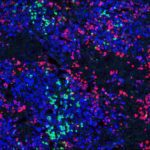Link to Pubmed [PMID] – 12297826
Hepatology 2002 Oct;36(4 Pt 1):794-804
This work shows that hepatic cell lines reproducibly can be derived from E14 embryos of many mouse inbred strains. These bipotential mouse embryonic liver (BMEL) cell lines present a mixed morphology, containing both epithelial and palmate-like cells, and an uncoupled phenotype, expressing hepatocyte transcription factors (HNF1alpha, HNF4alpha, GATA4) but not functions (apolipoproteins, albumin). BMEL cells are bipotential: under inducing conditions they express hepatocyte and bile duct functions. In addition, they can undergo morphogenesis in Matrigel culture to form bile duct units. When returned to basal culture conditions, the differentiated cells revert, within a few days, to an undifferentiated state. The ensemble of markers expressed by BMEL cells implies that they originate from hepatoblasts, the endodermal precursors of the liver. In conclusion, the establishment of a simple and reproducible method to isolate from any mouse embryo bipotential hepatic cell lines that exhibit the properties of transit stem cells provides a novel paradigm for investigation of hepatic cell lineage relationships.


